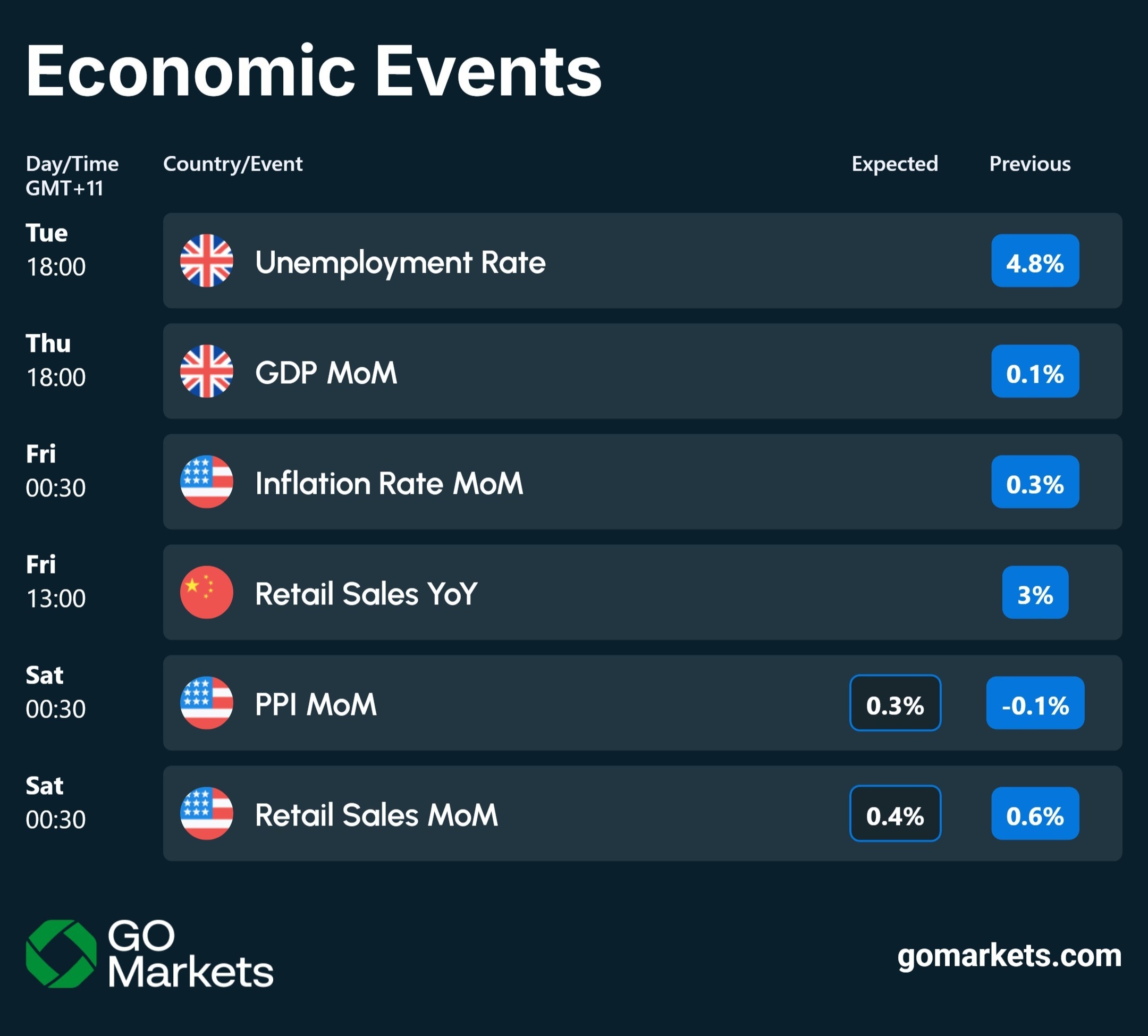ข่าวสารตลาด & มุมมองเชิงลึก
ก้าวนำตลาดด้วยมุมมองเชิงลึกจากผู้เชี่ยวชาญ ข่าวสาร และการวิเคราะห์ทางเทคนิค เพื่อเป็นแนวทางในการตัดสินใจซื้อขายของคุณ.

Markets retreated last week, pulling back about 2.5-3% from record levels. While the decline is modest, it is marked by several headwinds that could create further pressure this week.
Government Shutdown Reaches Historic Length
The ongoing shutdown has now reached record duration, and there's still no clear resolution in sight. Healthcare remains the primary sticking point between the two sides. Some reports suggest potential progress, but the jury's still out on whether any deal will materialise or gain bipartisan support before the Thanksgiving holiday season.
Key Economic Data May Be Delayed
The shutdown's impact extends to data releases. Market-influencing government reports, including jobs numbers and CPI data, may be delayed this week — CPI is still technically scheduled, but the shutdown could affect its release. This data delay will make it harder to gauge the economy's true direction and could inject further volatility into markets.
Earnings Season Continues to Impress
Despite these macro headwinds, corporate America is delivering exceptional results. We're seeing an 82% EPS beat rate and 77% of companies exceeding revenue expectations. While we're in the final 10% of S&P 500 reports, some important retail stocks are still due. These consumer-facing companies could provide valuable insights into spending patterns and economic health.
NVIDIA Tests Critical Support Level
AI stocks are facing pressure, with NVIDIA testing a key technical level around $180-$185. The stock experienced five consecutive days of losses before bouncing strongly on Friday with a major wick rejection. If support at $180 breaks, we could see a drop to $165. However, Friday's bounce suggests a possible retest of $193. This is a crucial moment for the AI sector leader, and its direction could influence broader tech sentiment.
Market Insights
Watch the latest video from Mike Smith for the week ahead in markets.
Key economic events
Keep up to date with the upcoming economic events for the week.



US indices retraced overnight as the market took a step back to assess the recent rally. The Nasdaq finished down 1.32%, the Dow Jones Index was down 1.29% and the S&P 500 was 1.23% in the red. Despite the selling, the session was still a far cry from recent sell-offs.
In Europe, the DAX slumped 1.31% after showing some strength early in the day. The FTSE continues to be the stronger of the indices due to its geographical protection against the Russian/Ukraine conflict and the rising oil and other commodity prices. CPI figures in the UK announced earlier in the day were slightly higher than expected at 6.2% vs an expected rate at 6%.
However, the UK has already enacted steps to combat inflation ahead of many other countries. Commodities Oil prices spiked again, as disruptions to Russian and Kazakh crude exports will reduce exports by up to 1 million barrels a day or 1% of global production due to storm damage. This caused oil shorts to squeeze as Brent Crude to pump 6.04% to 121.40 USD.
Gold continues to build a base as it closed the night up 1.21% to 1,944.03 USD per ounce. Natural Gas made early gains but was not able to hold its highs as it sold off from the supply zone at 5.3 USD. Natural gas is still holding the 5.10 USD support level as it ended the day o.41% down.
Cryptocurrency Bitcoin had a choppy day as it remained range-bound for the session as the BTC/USD closed up 0.22% overall. Ethereum again continues to outperform BTC and rose by 1.44% as it gets closer to breaking out of the $3050 level. ETH/USD ended the day at $3016.
FOREX The AUD/USD touched $0.75 overnight but has not yet been able to push through the area of resistance. The pair is one to keep an eye on as movement in either direction may provide an opportunity for the market to pounce. The USD/JPY also continues to go up in an almost vertical direction.
The pair finished up 0.32% for the session. The GBP/USD finished 0.44% lower on the back of the UK inflation figures, with the pair trading at 1.3200 USD.


The OPEC group has announced plans to increase production of Crude oil to reduce the panic and ease the supply crunch. However, some analysts believe that the amount will be insufficient reduce the price. The organisation agreed to increase production to 648,000 barrels from 400,000 per day beginning in August.
Brent crude and WTI dropped in price in response, although they did settle as the day progressed. Background The price of oil initially spiked in response to the Russian and Ukraine crisis as sanctions were placed on Russia and supply chains began to come under stress. This caused a supply shock, and prices began to rocket up.
The added pressure of record high inflation has only accelerated the prices higher. Despite the increase in production, the emerging countries who produce oil are already struggling to keep up with their production targets. For instance, Nigeria, Venezuela, and Libya are struggling to produce their required amount for various reasons and have been set over ambitious targets.
This leaves the USA and Saudi Arabia are left to pick up the slack. Geopolitical Problems Political forces are also at play whenever oil is mentioned. Russia has such a powerful role in the production.
Restrictive economic sanctions placed on them since the crisis began has only added to uncertainty and volatility. Analysts believe that reducing the Russian influence on OPEC may reduce the volatility of oil prices, however this strategy will ultimately fail if Russia produces less oil and not more. Isolating Russia and placing more sanctions on them may prove counterproductive to dealing with oil supply.
Initial price action The price of oil dropped on the news with both WTI and Brent Crude oil dropping significantly. WTI dropped by 3.44% whilst Brent dropped 2.93%. Both prices remain volatile and in pattern of medium-term consolidation.
The price remains at the mercy of inflation rates and geopolitical influences.


Nike Inc. (NKE) reported its latest financial results for its fiscal 2022 fourth quarter after the closing bell in the US on Monday. World’s largest sporting goods company topped both revenue and earnings per share estimates. The company reported revenue of $12.234 billion for the quarter vs. $12.061 billion expected.
Earnings per share reported at $0.90 per share vs. estimate of $0.80 per share. ''NIKE’s results this fiscal year are a testament to the unmatched strength of our brands and our deep connection with consumers," John Donahoe, President and CEO of Nike said in a press release after the results. ''Our competitive advantages, including our pipeline of innovative product and expanding digital leadership, prove that our strategy is working as we create value through our relentless drive to serve the future of sport," Donahoe added. Nike Inc. (NKE) chart Shares of Nike were down by around 2.13% at the end of trading day on Monday at $110.42 per share. Here is how the stock has performed in the past year: 1 Month -4.73% 3 Month -18.03% Year-to-date -33.70% 1 Year -27.47% Nike price targets Cowen & Co. $133 Deutsche Bank $152 Credit Suisse $130 Citigroup $123 Baird $150 UBS $168 Morgan Stanley $159 HSBC $132 Wells Fargo $150 Nike Inc. is the 61 st largest company in the world with a market cap of $173.90 billion.
You can trade Nike Inc. (NKE) and many other stocks from the NYSE, NASDAQ, HKEX and the ASX with GO Markets as a Share CFD. Sources: Nike Inc., TradingView, MarketWatch, Benzinga, CompaniesMarketCap


The New Zealand economy took a hit in the first quarter as Covid 19 ran rampant and interest rates rose as the Reserve Bank of New Zealand increased interest rates to combat inflation. The contraction was exaggerated as imports were reduced. Growth across the country was slowed.
Production based output or the GDP fell by 0.2% which was below the analyst’s expectation of a 0.6% increase. The figure was also a substantial level below the 3.0% rise seen in the December quarter. Primary industries drove the decrease.
Lower output in the food, beverage, and tobacco manufacturing industry as well as the agriculture, forestry and fishing industries were key reason for the reduction in growth. Housing prices dropped as the rising interest rates began to hit mortgage holders in the hip pocket. Prices dropped 5.6% in the three months to May.
The Reserve Bank of New Zealand also tempered its expectations predicting a modest 0.7% increase for the March quarter. New Zealand spent much of the quarter fighting the Omicron spread of Covid-19. It was the real time the small island country had to deal with a significant covid outbreak.
Despite this, domestic travel data remained strong. The country also in a bid to help the travel industry, opened it borders to international visitors. The Reserve Bank has already raised interest rates five times since October in a bid to stem inflation from getting worse.
The Bank also made it clear that slowing down inflation would take priority over protecting the economy against a recession. The New Zealand dollar dropped on the news before rallying and is currently buying 0.63 USD. The NZD recovered after the drop before settling.
The NZD.USD pair has been in a downward trend since March 2021. It has seen a recent test of the 2-year lows.


Energy prices have continued to soar with the US indices struggling again as the West debates placing more sanctions on Russia. The Nasdaq closed 3.62% down overnight and is officially in a Bear market after falling 20% since the November 2021 highs. The Dow Jones finished down 2.37% and has also confirmed a correction as it closed down 10% from the January highs.
The S&P 500 was also down 2.95%. In Europe the FTSE finished flat, recovering most of the morning losses to end the day down 0.40% overall. The DAX also worked back some of its morning losses but still closed the day down 1.98%.
Commodities continue to boom with the threats of an embargo on Russian supplies driving the market sentiment. Oil rose to a 14 year high touching $139 a barrel for Brent Crude. However, the price did fall back to the $130 level as the day wore on.
Natural gas also rocketed up 42% compared to Friday over the concerns of a shortfall if Russia were to cut off its supply to Western Europe. British Prime Minister Boris Johnson outlined that the West may need to increase Oil and Gas production reduce the reliance on Russia and enable sanctions to be implemented. The increase in supply pressure, especially in the short term may see the volatility continue.
Nickel was the largest mover overnight rising an incredible 73%. Nickel miners and commodity plays on the ASX may continue to be relevant as the volatility surrounding commodities continues. Bitcoin is trading relatively flat at the moment with BTC/USD at $38,027 at 10.00 pm GMT.
Ethereum is trading at 1.94% lower at $2500 at 10.00 GMT. FOREX The GBP/USD fell sharply finishing down 1.01% as investors continue moving to safe-haven currencies. The EUR/USD performed marginally better dropping 0.7%.
The NZD and AUD, which had been performing strongly in the prior week also tapered against both the USD and EUR. Gold continued to show strength as it hovers just below the $2000 per ounce level. The impact of the CPI figures that will be out on Friday may further impact gold prices.


NIO Inc. (NIO) reported its first quarter financial results before the market open in the US on Thursday. The Chinese electric vehicle maker reported revenue of $1.563 billion in the first quarter (up by 24.2% year-over-year), topping analyst estimate of $1.561 billion. Loss per share reported at -$0.12 per share, lower than the -$0.15 loss per share expected.
The company delivered a total of 25,768 vehicles in Q1 2022, an 28.5% increase vs. Q1 2021. William Bin Li, founder, chairman and CEO of the EV company commented on NIO’s performance in Q1: ''We set new record-high quarterly deliveries of 25,768 vehicles in the first quarter of 2022, and hit the milestone of exceeding 200,000 vehicle deliveries in May within four years since our first delivery.'' "Despite the volatilities of supply chain and the challenges in vehicle delivery resulting from the recent COVID-19 resurgence, we witnessed robust demand for our complementary products and achieved an all-time high order inflow in May 2022.
On April 29, 2022, the first batch of tooling trial builds of the ET5 rolled off the production line at the new manufacturing plant at NeoPark in Hefei. We expect to start delivery of the ET5 in September 2022. In addition, we will further enhance our product offering by introducing the ES7, a new mid-to-large five-seater SUV based on NIO Technology 2.0 (NT2.0), in June and expect to start its delivery in late August," Li added.
The company expects deliveries of between 23,000 to 25,000 in Q2 and revenue of between $1.473 billion and $1.591 billion. NIO Inc. chart Shares of NIO fell by around 6% during the trading day on Thursday at $18.93 per share despite beating analyst estimates for Q1, mainly due to future outlook for Q2. Here is how the stock has performed in the past year: 1 Month +44.35% 3 Month +42% Year-to-date -40.31% 1 Year -55.78% NIO price targets B of A Securities $26 UBS $32 Mizuho $60 Morgan Stanley $34 Barclays $34 Deutsche Bank $70 Goldman Sachs $56 NIO is the 14 th largest automaker in the world with a market cap of $31.54 billion.
You can trade NIO Inc. (NIO) and many other stocks from the NYSE, NASDAQ, HKEX and the ASX with GO Markets as a Share CFD. Sources: NIO Inc., TradingView, MarketWatch, Benzinga, CompaniesMarketCap

